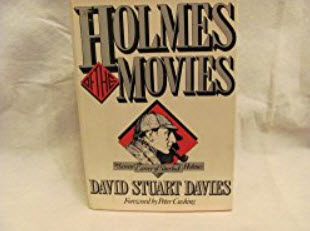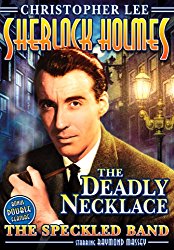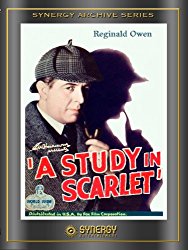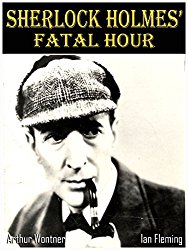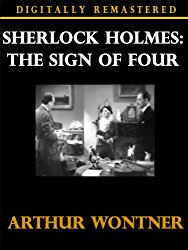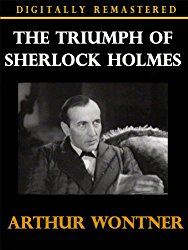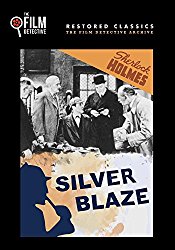Sherlock Holmes in
the Movies: Part 3
Talking Holmes -- The Early Talkies
Clive Brook starred as Holmes in the silent film The Return of Sherlock Holmes (1929). I've been unable to find this film so cannot comment on it.
|
However, in 1932 Clive Brook made a talkie called Sherlock Holmes. Davies calls it "...a highly efficient thriller with a plot which involved Moriarty's revenge and his plan to get Holmes to the gallows by forcing him into a murder" (Holmes of the Movies). I read comments in a forum recently that indicated that some viewers found it slow moving, but I did not find it so. In fact, I am quite delighted with it and there are some "shoot 'em up" action sequences. The added bonus for me is hearing Clive Brook emulate William Gillette's delivery of Holmes's lines. |
Click Image to Click the image below to |
Raymond Massey appeared as Holmes in The Speckled Band (1931). This film was based on Doyle's play rather than the short story version. This, too, was modernized when Holmes creates a database to track criminals. He frustrates his secretary by constantly adding, deleting, or modifying information.
|
Click Image to Click the image below to Click Image to Click the image below to |
We are fortunate indeed to have Lyn Harding's performance as Dr. Grimesby Rylott. (Harding later appears as Professor Moriarty in two films with Arthur Wontner, described later in this article.) Reginald Owen, who played Dr. Watson in the 1932 Clive Brook film, appears as Sherlock Holmes in A Study in Scarlet (1933). This film has very little to do with the novel of the same name. (Only about a page of dialogue was used from Doyle's novel.) Neither Owen nor Massey before him emulated William Gillette. Massey's appearance as Holmes was fresh and original, but Owen's was uninspired. Although there are occasionally interesting camera angles, major action occurs off-screen and the film is slow moving. Davies writes, "The verbose and tedious film had little to recommend it." Incidentally, Davies tells us, "Owen has the distinction of being the only actor to have played both Holmes and Watson." This, of course, is no longer true -- Jeremy Brett played Watson to Charlton Heston's Holmes in the play "The Crucifer of Blood." Later Brett starred as Holmes in the BBC/WGBH television series. |
Arthur Wontner
1931 also introduced Arthur Wontner as Sherlock Holmes. When I watch Arthur Wontner perform, I am reminded of a portrait of Holmes that a researcher turned up. Doyle had written on its back, "This comes closest to my conception of what Holmes really looked like."
Davies called Wontner the "Critics' Choice," and, as noted on another page on this website, Vincent Starrett initially wrote that, while no actor could supplant William Gillette as Holmes, Arthur Wontner was born to play the part of Holmes for a later generation. (In an updated edition of The Private Life of Sherlock Holmes, Starrett later replaced Wontner's name with that of Basil Rathbone.)
The first Wontner film was called The Sleeping Cardinal (American title Sherlock Holmes' Fatal Hour). This "clever blending of 'The Empty House' and 'The Final Problem'" was "...the longest of the Wontner films, the slowest paced, but in many ways the best" (Davies).
When I watch this film I have the impression that it was filmed as though it were a stage production. There is very little camera movement and one is reminded of Marshall McLuhan's familiar dictum "We live in the rear-view mirror," which suggests (to me, anyway) that we often fail to take advantage of new technology.
The Sign of Four (1932) had a lot of action and embellished the "circus side show" which was obliquely referenced in the novel.
|
Click Image to Click the image below to |
Click Image to Click the image below to |
The Missing Rembrandt (1932) was loosely based on "Charles Augustus Milverton." (This is the one Arthur Wontner film I've been unable to find, although it is reported to have been discovered and may be available in the collectors' market.)
The Triumph of Sherlock Holmes (1935) is a brilliant adaptation of Doyle's novel The Valley of Fear. We are treated to Lyn Harding as Professor Moriarty. (I absolutely love this film because it follows the storyline so faithfully!)
Silver Blaze (1937). Arthur Wontner was called out of retirement to portray Holmes in this, Wontner's final appearance as the master detective. To flesh out the short story, the film has Holmes visiting his old friends the Baskervilles. This was fortunate for, while the film didn't do well at the box office, it enabled the studio to reissue it under the title Murder at the Baskervilles after Basil Rathbone's Hound of the Baskervilles proved such a great hit.
Silver Blaze was true to the story, Lyn Harding again appeared as Professor Moriarty, and this is a worthy addition to any collector's library. Although Wontner is somewhat older in this film, he still portrays a very enjoyable Holmes.
|
Click Image to Click the image below to |
Click Image to Click the image below to |
Der Hund von Baskerville (1937)
In January 1937, the German film Der Hund von Baskerville (The Hound of the Baskervilles) was released. I've only recently seen this version and, although the copy I reviewed had no English subtitles and I understand very little German, I know the story well enough to follow it.
It is suitably atmospheric. Bruno Guttner (as Holmes), Fritz Odemar (Dr. Watson), and Peter Voss ("Lord" Henry Baskerville) did a credible job and look the part of the character each portrayed. (I'd love to see it with subtitles because I missed some of the dialogue interplay between characters!)
Even with only one viewing I was able to catch a couple of scenes that may well have been "borrowed" by 20th Century Fox when they made the Basil Rathbone version a couple of years later. In one scene, Holmes covers the face of a portrait with his hand, revealing only the eyes (which vividly expose who the villain is).
The second scene that I believe likely influenced 20th Century Fox was the death of the villain (which I don't want to give away or spoil for you).
Der Mann, der Sherlock Holmes War ("The Man Who Was Sherlock Holmes") (1937)
This film is an unexpected delight for me. I was able to view a copy with English subtitles. I first read about this film more than forty years ago but knew nothing about it. David Stuart Davies simply said it was a spoof, but I was not prepared for the sheer fun I enjoyed while watching it.
Two con men dress up as Holmes and Watson. (Actually, there's more to it than this but, again, I don't want to spoil it for you!)
People think they're really Holmes and Watson, although they deny it vociferously. This is a ruse intentionally devised to convince people that they are, indeed, the master detective and his biographer. In the process they are given some cases to solve, which they accept and follow through with. The investigations and deductions are right on target and very satisfying for a Holmes enthusiast. The film is a comedy but includes genuine suspense and romance.
In one scene, Holmes is in one bathtub in a hotel while Watson is in another bathtub in the same suite. Both are singing away ("Jawohl, meine Herr'n," which proved to be a big hit among audiences).
Holmes (actually the character Morris Flynn) is played by Hans Albers, and Dr. Watson (a.k.a. Macky McMacpherson) is played by Heinz Ruhmann. Albers and Ruhmann have been well-known stars of cinema in Germany.
Because of their impersonating Holmes and Watson, they are eventually put on trial. During their defense and the denoument of the film Holmes (i.e., Flynn) reveals the solutions to a number of their "cases" and there is a surprising, and surprisingly delightful and satisfying, conclusion. An unexpected eyewitness presents himself on their behalf. Now that I've seen it I feel confident that it is destined to become one of my favorite films and I expect to watch it many times in the future.
|
To Be Continued... |
Sherlock Holmes | Home
Amazon and the Amazon logo are trademarks of Amazon.com, Inc. or its affiliates.
(This is a link through which I make a small commission if you buy. See here for more details.)
